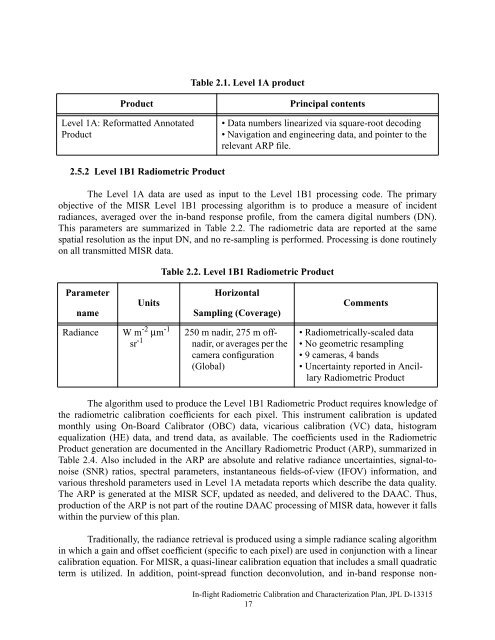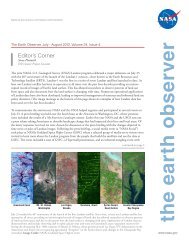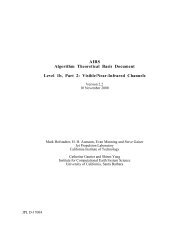MISR: In-Flight Radiometric Calibration and Characterization Plan
MISR: In-Flight Radiometric Calibration and Characterization Plan
MISR: In-Flight Radiometric Calibration and Characterization Plan
You also want an ePaper? Increase the reach of your titles
YUMPU automatically turns print PDFs into web optimized ePapers that Google loves.
Table 2.1. Level 1A productProductLevel 1A: Reformatted AnnotatedProductPrincipal contents• Data numbers linearized via square-root decoding• Navigation <strong>and</strong> engineering data, <strong>and</strong> pointer to therelevant ARP file.2.5.2 Level 1B1 <strong>Radiometric</strong> ProductThe Level 1A data are used as input to the Level 1B1 processing code. The primaryobjective of the <strong>MISR</strong> Level 1B1 processing algorithm is to produce a measure of incidentradiances, averaged over the in-b<strong>and</strong> response profile, from the camera digital numbers (DN).This parameters are summarized in Table 2.2. The radiometric data are reported at the samespatial resolution as the input DN, <strong>and</strong> no re-sampling is performed. Processing is done routinelyon all transmitted <strong>MISR</strong> data.Table 2.2. Level 1B1 <strong>Radiometric</strong> ProductParameternameUnitsRadiance W m -2 µm -1sr -1HorizontalSampling (Coverage)250 m nadir, 275 m offnadir,or averages per thecamera configuration(Global)Comments• <strong>Radiometric</strong>ally-scaled data• No geometric resampling• 9 cameras, 4 b<strong>and</strong>s• Uncertainty reported in Ancillary<strong>Radiometric</strong> ProductThe algorithm used to produce the Level 1B1 <strong>Radiometric</strong> Product requires knowledge ofthe radiometric calibration coefficients for each pixel. This instrument calibration is updatedmonthly using On-Board Calibrator (OBC) data, vicarious calibration (VC) data, histogramequalization (HE) data, <strong>and</strong> trend data, as available. The coefficients used in the <strong>Radiometric</strong>Product generation are documented in the Ancillary <strong>Radiometric</strong> Product (ARP), summarized inTable 2.4. Also included in the ARP are absolute <strong>and</strong> relative radiance uncertainties, signal-tonoise(SNR) ratios, spectral parameters, instantaneous fields-of-view (IFOV) information, <strong>and</strong>various threshold parameters used in Level 1A metadata reports which describe the data quality.The ARP is generated at the <strong>MISR</strong> SCF, updated as needed, <strong>and</strong> delivered to the DAAC. Thus,production of the ARP is not part of the routine DAAC processing of <strong>MISR</strong> data, however it fallswithin the purview of this plan.Traditionally, the radiance retrieval is produced using a simple radiance scaling algorithmin which a gain <strong>and</strong> offset coefficient (specific to each pixel) are used in conjunction with a linearcalibration equation. For <strong>MISR</strong>, a quasi-linear calibration equation that includes a small quadraticterm is utilized. <strong>In</strong> addition, point-spread function deconvolution, <strong>and</strong> in-b<strong>and</strong> response non-<strong>In</strong>-flight <strong>Radiometric</strong> <strong>Calibration</strong> <strong>and</strong> <strong>Characterization</strong> <strong>Plan</strong>, JPL D-1331517







